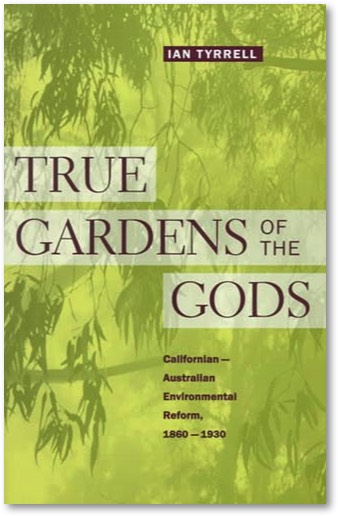
Musings » True gardens of the Gods: Californian-Australian environmental reform, 1860 - 1930


Berkeley -- Los Angeles -- London
University of California Press 1999
There is nothing new under the sun. Modern economists like to believe they invented the concept of the “Pacific Rim” as a trading bloc. Those of us in the garden history racket know better. Almost as soon as there were an Australia and a California, vigorous trade developed between the two. The almost simultaneous gold rushes started it off and it was quicker to go from Australia to California than to go from New York to California at that time.
Plants were among the earliest items of trade. In 1867, James Welch brought a ship- load of Australian trees into San Francisco and auctioned them off at the wharf. Just as merchandise was exchanged so were theories and ideas.
Ian Tyrell, a professor of history at the University of New South Wales in Sydney, has written a very densely argued and compelling book about the resonances in environmental thinking between the two places.
The dominant myth in developing California was that of the “garden”. Nature alone was all very well in its way but in the late nineteenth century, nature “improved” was much better. The notion of “Eden” and the garden drove the thinking. Nowhere was this so clear as in the long period during which irrigation promised to cure all the social ills which already cursed California. Idealists such as Henry George touted the Jeffersonian theory of sturdy yeoman farmers (read horticulturist/ fruit farmers) firmly established in their own small plots, knitting rural communities together.
Australia had even larger deserts and the “bush” to contend with. Settlement was further apart and sparser. Trees were seen as the answer to chronic shortages of water. They anchored the soil, preventing run off and flooding during rainy seasons. Water could be conserved and kept tidily for future use.
All these enlightened and utopian notions foundered on the harsh reality of frontier business practices. The laws of unintended consequence operated extremely harshly in California land speculation. Rather than charming small country towns coming into being, the speculation led to larger and larger agribusiness operations which persist to this day.
Kevin Starr has said that “California beckoned, gleaming with promise but dripping with blood”. Even without the murder and rapine which accompanied the formation of the state, California horticulture suffered from the naiveté of early legislators.
In Australia, the enthusiasts also supposed that irrigation, controlled at a local level, would keep small farms in business and create a “manufactured” garden landscape.They copied California’s technical methods, with all their complexity.
Some of the earliest systems were too effective. One rancher complained that irrigating his land led to an infestation of snails. In Pasadena, Shorb and Titus both used iron pipes to irrigate their vineyards.The iron eventually rusted.
Australian experts consulted William Hammond Hall, in his incarnation as California state engineer. Hall devoted his time to hydrology and incurred the wrath of the state’s government. The state of Victoria sent its ministers to examine California’s systems at first hand. In return Henry George went to Australia to preach land reform. None of these people had any idea that irrigation would damage the soil.
Tyrrel is exceedingly thorough. He brings the narrative almost up to the present by examining the rise of economic entomology, a science in which Californians excelled. After Rachel Carson had shown the devastation caused by pesticides, the idea of biological control began to be considered.
This is a book to savor, to read slowly and think about each section, as the author intended. The similarities and differences between the arid regions of Australia and California remain fascinating.

